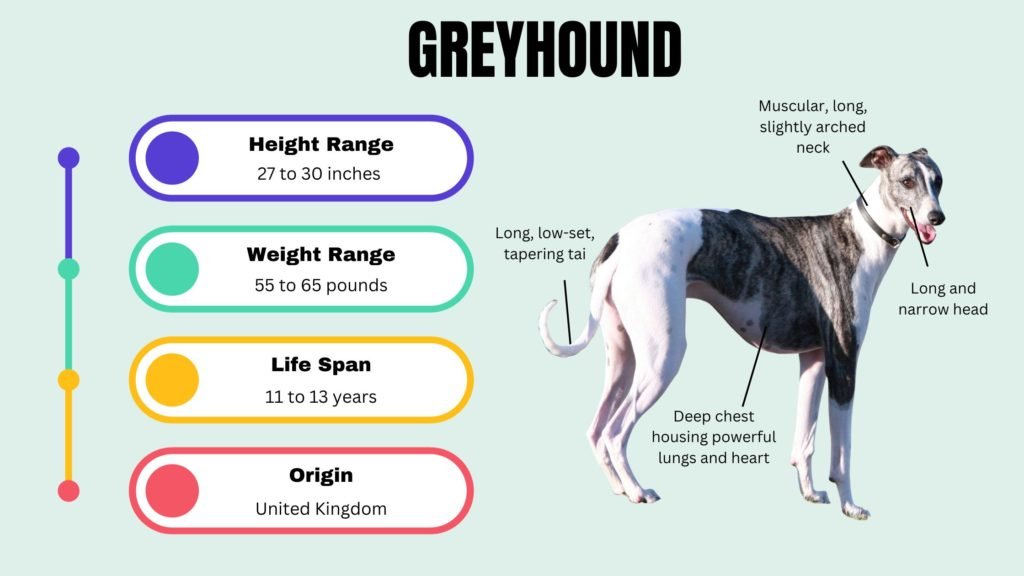History of the Greyhound
The Greyhound is one of the oldest and most fascinating breeds of dogs, with its origins tracing as far back as 4,000 years ago. Unearthed remains of dogs resembling the Greyhound have been found in places like Tell Brak in modern Syria, giving credence to its ancient lineage. The breed has been mentioned in various historical texts, including Arrian, who spoke of a sighthound known as the vertragus, believed by many to be an antecedent of the modern Greyhound. The breed’s history might have roots among the Celts from Eastern Europe or Eurasia.
In the British Isles, systematic archaeology conducted in the 1970s could not find evidence of a true Greyhound-type before the Roman occupation. During this period, the vertragus became known to the occupying troops. The modern Greyhound was recorded and registered first in private studbooks in the 18th century, followed by public ones in the 19th century in the United Kingdom. Initially bred for hunting, the Greyhound gained prominence in coursing and track racing, showcasing its incredible speed and agility.

Characteristics of the Greyhound
The Greyhound is a marvel of canine physiology. A lean, muscular body and an impressively large heart allow the dog to reach astonishing speeds. Their body is optimized for aerodynamic efficiency, allowing for a unique double-suspension gallop that lifts them off the ground during strides. Another distinguishing characteristic is their exceptional eyesight, keen enough to spot a hare or quarry at great distances.
Health-wise, the Greyhound is generally a robust breed but is prone to certain conditions like esophageal achalasia, gastric dilation volvulus (bloat), and osteosarcoma. Their skin is also more sensitive than many other breeds, making soft bedding necessary. Another quirk is their metabolism; they can’t metabolize barbiturate-based anesthesia like other dogs, requiring specialized veterinary care.
Moreover, Greyhounds possess a unique blood chemistry, including higher levels of red blood cells. This enables them to carry more oxygen to their muscles, enhancing their sprinting capabilities. However, they have lower platelet levels, making them susceptible to certain blood conditions.
Personality of the Greyhound
A Greyhound is more than just a high-speed runner; it has a multifaceted personality that often surprises those unfamiliar with the breed. They are generally laid-back and even-tempered, showing a fondness for relaxation when not sprinting after a lure or potential prey. This disposition makes them excellent companion animals and even suitable as apartment dogs since they don’t require a lot of space and are relatively inactive indoors.
One of the unique aspects of a Greyhound’s personality is its sensitivity. They respond best to gentle commands and can be skittish if handled roughly. This sensitivity extends to their sociability; they generally get along well with humans and other dogs, although their tolerance for smaller animals can vary due to their high prey drive.
Contrary to a common misconception, Greyhounds are not hyperactive but rather quite the opposite. They are happy to lounge around the house and are known for sleeping up to 18 hours a day. However, they are always up for a quick sprint, so they must be kept on a leash or securely fenced to keep their prey drive in check.
Despite their racing reputation, Greyhounds are among the least aggressive dog breeds, showing low hostility towards strangers and other dogs. They’re even known to be good with children as long as the kids are taught to treat them respectfully. Greyhounds are rarely barkers, adding to their suitability for various living environments.
Life Span
The life span of a Greyhound is generally between 10 to 14 years, a reasonably long stretch for a large breed. This longevity is partly attributable to the breed’s overall good health, although they are prone to specific ailments like osteosarcoma and bloat. The secret to their longer life span often comes down to their lifestyle, which typically involves lower stress levels, especially when they are adopted into loving homes after their racing career. Their unique physiology, including a higher count of red blood cells, plays a role in their generally robust health. In this breed, longevity is not merely about the quantity of years lived but also the quality of life during those years.
Family Life
Greyhounds are known for being excellent family pets. They are gentle, loving, and very tolerant of children. They often enjoy the noise and activity of being part of a large family. They can be reserved but are never overly aggressive or territorial, making them ideal for homes with multiple occupants. They can adapt to different living situations, whether a large house with a backyard or a small apartment, as long as they get their daily dose of exercise and love. A Greyhound could fit right in if you have a family, especially with kids who are old enough to treat pets respectfully.
Habitat and Diet
Typically, Greyhounds require a living environment that is more indoor-oriented. Their thin coat and lack of body fat make them susceptible to extreme weather conditions. They should have soft bedding to prevent skin sores and must be protected from extreme temperatures. Diet-wise, they need high-quality dog food well-suited to their age, size, and activity level. Given their lean physique, it’s essential to manage their weight carefully. An overweight Greyhound can suffer from a range of health issues. Fresh water should always be available, especially since they can be prone to dehydration.
Temperament
One of the most striking characteristics of Greyhounds is their calm and composed temperament. Contrary to popular belief, they are not hyperactive animals. Greyhounds love to laze around and can sleep up to 18 hours daily! They are sensitive animals and respond best to calm and gentle commands. They rarely bark, making them ideal for suburban or apartment living. Their sensitivity also means they can be prone to separation anxiety, so they do best in environments where someone is usually home. Training them is generally easy due to their intelligent and eager-to-please nature. However, because they are sighthounds, they can be very focused and stubborn when locked onto a target.
Behavior with Other Animals
Greyhounds can be pretty friendly and usually get along well with other dogs. However, their prey drive is strong, meaning they may only sometimes be compatible with smaller pets like cats or rabbits if they are trained from a young age to co-exist with them. If you have other pets, you should always supervise their first interactions with the Greyhound. Over time, many Greyhounds do learn to live peacefully with other animals, even those they might usually consider prey. But every Greyhound is different, and it’s important to remember that their high prey drive doesn’t make them aggressive; it’s just a part of their genetic makeup.
Coat Color and Grooming
The Greyhound’s coat is nothing short of a spectacle in the canine world. They come in various colors: black, blue, brindle, fawn, red, white, or a mix. This variety in coloration adds to their aesthetic charm. Grooming is generally breezy, thanks to their short, sleek coat that doesn’t tangle easily. However, their skin is thin and sensitive, requiring you to choose grooming tools carefully. A soft-bristle brush is ideal.
Additionally, some Greyhounds have dandruff issues, which could necessitate an oatmeal-based shampoo for bathing. Despite their low grooming requirements, these dogs require protection against colder weather conditions. Specialized Greyhound coats or sweaters are commonly used during chilly months.
Health
Greyhounds are mostly a robust breed but are predisposed to some specific health issues. They are at a higher risk for osteosarcoma, a bone cancer that demands early diagnosis and aggressive treatment. Another primary concern is gastric torsion or bloat. Given their deep-chested anatomy, gas can accumulate in their stomachs, causing painful and often dangerous swelling. Immediate veterinary intervention is crucial. Besides these, they are susceptible to hip dysplasia and some cardiac issues. A high-quality diet rich in protein and fiber and routine vet check-ups can go a long way in safeguarding their health. Moreover, weight management becomes essential to their health regimen given their sedentary lifestyle.
Price
The price tag on a Greyhound can vary significantly based on several factors. These factors include the dog’s age, sex, size, coat color, health condition, lineage, and even the geographical location of the breeder. So, if you want to bring a Greyhound into your life, prepare for a wide price range. You could pay as little as $300 for an older dog you find at a shelter or rescue. On the flip side, if you’re after a Greyhound puppy with a high-quality pedigree, be prepared to shell out upwards of $2,500 or more.
For those interested in the racing circuit, Greyhound Racing in Victoria suggests a budget of around $2,500 for a puppy that shows racing potential. But remember, this is merely an upfront cost. Training, maintenance, and potential veterinary expenses for a racing dog will add substantially to your initial investment.
Online platforms like NextDayPets.com offer a snapshot of the current market trends for Greyhound prices. As of 2017, the median price stood at $775. However, if you’re looking for a top-tier Greyhound with a superior lineage, complete with breeding rights and official papers, the costs can rocket to anywhere between $2,000 and $7,000.
Trainability
In terms of training, Greyhounds are a mixed bag. They’re intelligent dogs, capable of learning commands swiftly, but their sensitive disposition requires a gentle, positive reinforcement-based training regimen. Harsh tones and punitive measures can be counterproductive. Socialization training should start early, given their instinctual prey drive. However, training them to walk off-leash in open spaces is generally not recommended, as their prey drive can be overpowering.
Care
Ongoing care involves a balanced blend of physical activity, nutrition, and emotional connection. Despite Greyhound’s innate speed, Greyhounds are not high-energy dogs requiring hours of exercise. However, they do relish the occasional sprint. A secure, fenced-in area is ideal for them to stretch their legs. They enjoy a meat-rich diet, but portion control is essential to prevent obesity. Socially, they tend to be somewhat aloof but usually form strong bonds with their human families. Regular health check-ups are non-negotiable, given their predisposition to specific medical issues.
Greyhounds are a remarkable and somewhat paradoxical breed—fast yet not overly active, strong but sensitive, independent yet capable of deep bonds. Their unique coat colors and low grooming needs make them attractive to prospective owners. Still, their healthcare demands and associated costs require committed and informed caretaking. A keen understanding of their personality, trainability, and care requirements is crucial for anyone contemplating bringing a Greyhound into their life.

